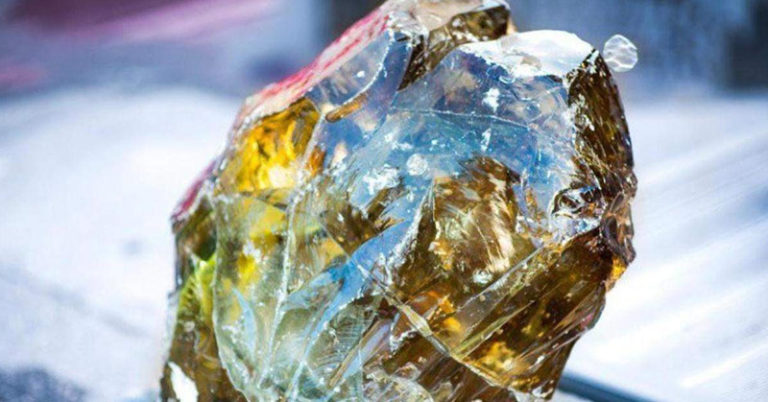Our beloved planet is full of varying types of minerals. Some of these are common, and some are exceedingly rare. The universe contains an even greater array of “impossible to naturally exist” materials, thanks to its vastly different atmospheric conditions. A few years ago, meteorologists discovered a mystery meteorite that contains an ultra-rare quasicrystal.
This is only the third time scientists have seen this type of crystal in nature.
What is a Quasicrystal?
To understand what a quasicrystal is, you first need to understand a regular crystal. Examples of regular crystals include snowflakes, diamonds, and table salt. These types of crystals are made up of atoms that are arranged in almost perfect symmetry, in repeating patterns [1,2].
Polycrystals include most metals, rocks, and ice. Their structures are more randomized and disordered, similarly to amorphous solids like glass, wax, and many plastics.
Quasicrystals, on the other hand, consist of a completely unique atomic structure. Their atoms are still ordered, but the pattern isn’t periodic- it doesn’t repeat. Essentially, quasicrystals combine the symmetrical properties of a regular crystal with the chaotic arrangement of an amorphous solid [1,2].
Pat Theil is a senior scientist at the US Department of Energy’s Ames Laboratory. He explains quasicrystals using floor tiling as a metaphor.
“If you want to cover your bathroom floor, your tiles can be rectangles or triangles or squares or hexagons,” she said. “Any other simple shape won’t work, because it will leave a gap.” [3]
Quasicrystals, like the ones found in this mystery meteorite, are like pentagons. Pentagons can’t fit together as squares or triangles can. To solve this problem, nature places other atomic shapes into the gaps. Theil refers to these as glue atoms [3].
A Controversial Discovery
Scientists have known about quasicrystals long before finding them in this mystery meteorite. Many of them, however, did not believe they were real.
Before the 1980s, scientists thought that crystals and amorphous solids were the only types of solids that could exist [4]. In 1982, however, Israeli chemist Daniel Shectman proposed the existence of quasicrystals. His colleagues laughed him right out of the lab.
His peers ridiculed him for decades, telling him that a semi-ordered structure wasn’t possible. Why? Because until that point, scientists believed that perfect symmetry in atomic structures followed very strict rules:
In order for a structure to grow with a repeating, symmetrical structure, it had to consist of one of four types of rotational symmetry: two-fold, three-fold, four-fold, and six-fold. (This should take you back to the floor tile example).
Quasicrystals break this rule because they have five-fold rotational symmetry [1].
Eventually, other scientists got on board with Shectman’s research, and they started making quasicrystals in the lab. Experts were still not sure, however, if such crystals could exist in nature [4].
That is, until the discovery of a mystery meteorite.
A Mystery Meteorite
In 2009, scientists were studying samples from the Khatyrka meteorite in northeastern Russia. Within this mystery meteorite, they found two examples of quasicrystals that matched with crystals they’d made in the lab.
This was the first time scientists had found quasicrystals outside the lab, proving that they can, in fact, exist in nature [4].
The researchers continued to study the meteorite, and in 2016 they found a third example of a quasicrystal.
Boris Shustov is the head of the Institute of Astronomy of the Russian Academy of Science. He says that it is common to find new materials in meteorites because they form under conditions that are different from those that exist on earth.
“This is a fairly common phenomenon due the fact that a number of minerals and substances that can be formed and are formed under cosmic conditions, are not found on Earth,” he said [5].
The minerals in this mystery meteorite are microscopic. The scientists said that it was subjected to temperatures greater than one thousand degrees celsius, which allowed it to form grains less than five micrometers in size.
Chi Ma is the director of the Analytical Facility of the Geological and Planetary Sciences division at Caltech. He says that the Khatyrka meteorite is the only space rock we know of that contains metallic aluminum. Ma and his team have also discovered 35 other minerals in this meteorite [1].
Mystery Meteorite: Further Study Ahead
Scientists still have many questions about the minerals in this mystery meteorite, such as how they came to be in the first place. The researchers suggest that it was possibly due to a collision between asteroids. The violent impact of such an event could provide the necessary heat and energy to form quasicrystals. Unfortunately, they have no way of proving this [4].
The discovery of this new, never-before-seen quasicrystal demonstrates that we still have much to learn about this unique type of matter. As scientists continue to study this space rock, they hope to find even more types of extraterrestrial materials.
Keep Reading: Rock Used as a Doorstop Is Actually Meteorite Worth 100K
Sources:
- ‘One of The Rarest Crystals on Earth Has Been Found in a Russian Meteorite’ Science Alert. Published December 9, 2016.
- ‘Quasicrystals: the thrill of the chase’ Nature Sharon Glotzer.
- ‘What are Quasicrystals, and What Makes Them Nobel-Worthy?’ PBS Published October 5, 2011.
- ‘Khatyrka meteorite found to have third quasicrystal’ Phys Bob Yirka.
- ‘Space Rock With ‘Impossible To Naturally Exist’ Mineral Found in Siberia’ IB Times Nandika Chand Published July 24, 2019.

